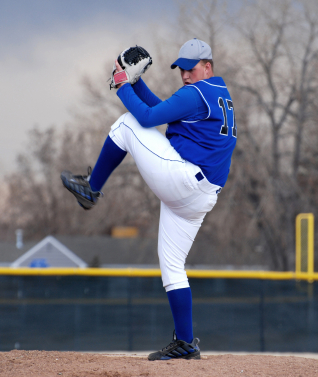Here are twelve ways to reduce the chance of injury to a baseball pitcher's elbow or shoulder:
1. Don't let your kid pitch when tired
This risk factor should not only be the easiest to understand, but it's also one of the biggest reasons for injury.
Because fatigue, like pain (another early warning sign of overuse injury), is subjective, and most pitchers won't tell you they are tired, it is usually up to the coach to use his observational skills and judgment to detect signs of fatigue, usng pitch counts,
ball velocity, ball location, pitching mechanics, and strength to detect whether a pitcher is tired.

For the warning signs of fatigue, click here.
2. Don't let your kid play baseball year-round
Research1 shows that youth baseball pitchers who pitch competitively more than 8 months a year are 5 times more likely to require surgery than those who take at least a four month break from throwing. This is particularly true for pitchers in warm-weather climates, who tend to play more months of the year than those in cold-weather climates.
For more on what studies show are the risks from playing baseball all-year round and what the experts recommend in terms of time off, click here.3. Follow pitch count limits and rest periods
- Little League Baseball has strict limits on the number of pitches an athlete can throw, depending on age, and requires mandatory rest periods between pitching appearances.
- USA Baseball2 recommends pitch limits but does not mandate them, and knowledge of and compliance with the recommendations is poor.
- High school baseball does not currently have pitch limits, although, argues Dr. Andrews, there should be. "I have heard of kids who throw 160 pitches in a game and that's just not safe," he recently told ESPN.com.
Making sure kids don't exceed pitch limits is particularly difficult when they pitch for more than one team because the coaches may not communicate with each other. It thus may up to parents of youth baseball pitchers on independent travel and all-star teams competing in independently-operated tournaments to monitor pitch counts because of such lack of communication and because they may have NO rules at all on pitch limits and rest.
For a study by Little League critical of such programs,3 click here.
For pitch limits recommended by the the National Athletic Trainers' Association,4 click here.
4. Avoid multiple teams with overlapping seasons
More and more youth baseball players play on multiple teams at the same time. While doing so may give him/her more opportunities to develop his skills, and while the amount of pitching may be limited by league rule or the judgment of the coaches, playing on multiple teams with overlapping seasons increases the risk that he/she may end up exceeding pitch limits (or the 100 inning limit recommended by ASMI.2
If you do let your child play on more than one team at once, it may be up to you, as his parent, to keep track your child's pitch counts and days off and to insist that the coaches not exceed those overall limits.
The American Academy of Pediatrics' 2012 revised Policy Statement5 says "Young pitchers should avoid pitching on multiple teams with overlapping seasons," and calls for the enforcement of rest requirements across all teams.
The 2011 Little League pitching injury study3 emphasizes the importance of explaining to "coaches, parents and players the high risk and limited reward of travel ball and showcases."
5. Teach good throwing mechanics early
Poor pitching mechanics can put additional stress on a young arm and increase the risk of injury, experts say.
It will come as no surprise to anyone who watches youth and high school baseball with any regularity that pitchers in their teens have better throwing mechanics than younger pitchers.
For what studies have found about the role pitching mechanics plays in injury risk and teaching proper mechanics, click here.6. Make sure your child is properly conditioned
Most pitching injuries are caused by overuse, which may be the result of insufficient conditioning of certain muscles. All pitchers should incorporate conditioning and stretching exercises for the shoulder into an overall conditioning program. The muscles in the front of the arm are naturally stronger.
Because many shoulder injuries result from weaker muscles in the back of the arm that are used to stop the pitching motion, the conditioning program should emphasize building up those muscles.
The AAP5 says a preseason conditioning program that includes strengthening the core, the rotator cuff and the shoulder-stabilizing muscles (scapular stabilizers) may help reduce throwing injuries.
For an article on shoulder stretching and conditioning exercises, click here.








